Study on Overburden Fracture and Structural Distribution Evolution Characteristics of Coal Seam Mining in Deep Large Mining Height Working Face
Abstract
:1. Introduction
2. Engineering Background
2.1. Mining and Geological Condition
2.2. Experiments for Determining Rock Mechanical Properties
3. Physically Similar Simulation of Overburden Movement under Deep Large Mining Face Mining
3.1. Similarity Theory
3.2. The Basic Process of the Test Method
3.2.1. Experimental Device
3.2.2. Similar Materials for the Model
3.2.3. Model Stress Response Monitoring Method and Excavation Process
4. Result Analysis
4.1. The Breaking Characteristics of the Immediate Roof and Main Roof
4.2. Overburden Deformation Law Based on DIC
4.3. Structural Evolutionary Characteristics of Deep Large Mining Height Quarries
4.4. Mineral Pressure Manifestation Characteristics of Deep Large Mining Face
5. Conclusions
Author Contributions
Funding
Data Availability Statement
Conflicts of Interest
References
- Yi, S.; Abbasi, K.R.; Hussain, K.; Albaker, A.; Alvarado, R. Environmental concerns in the United States: Can renewable energy, fossil fuel energy, and natural resources depletion help? Gondwana Res. 2023, 117, 41–55. [Google Scholar] [CrossRef]
- Rehman, A.; Ma, H.Y.; Ozturk, I.; Radulescu, M. Revealing the dynamic effects of fossil fuel energy, nuclear energy, renewable energy, and carbon emissions on Pakistan’s economic growth. Environ. Sci. Pollut. Res. 2022, 29, 48784–48794. [Google Scholar] [CrossRef] [PubMed]
- Su, F.; Chang, J.B.; Li, X.; Fahad, S.; Ozturk, I. Assessment of diverse energy consumption structure and social capital: A case of southern Shaanxi province China. Energy 2023, 262, 125506. [Google Scholar] [CrossRef]
- Xu, J.H.; Kang, Y.; Wang, X.C.; Feng, G.; Wang, Z.F. Dynamic characteristics and safety criterion of deep rock mine opening under blast loading. Int. J. Rock Mech. Min. Sci. 2019, 119, 156–167. [Google Scholar] [CrossRef]
- He, M.C.; Cheng, T.; Qiao, Y.F.; Li, H.R. A review of rockburst: Experiments, theories, and simulations. J. Rock Mech. Geotech. Eng. 2023, 15, 1312–1353. [Google Scholar] [CrossRef]
- Yang, D.D.; Peng, K.; Zheng, Y.; Chen, Y.J.; Zheng, J.; Wang, M.; Chen, S. Study on the characteristics of coal and gas outburst hazard under the influence of high formation temperature in deep mines. Energy 2023, 268, 126645. [Google Scholar] [CrossRef]
- Wang, L.; Lu, Z.; Chen, D.P.; Liu, Q.Q.; Chu, P.; Shu, L.Y.; Ullah, B.; Wen, Z.J. Safe strategy for coal and gas outburst prevention in deep-and-thick coal seams using a soft rock protective layer mining. Saf. Sci. 2020, 129, 104800. [Google Scholar] [CrossRef]
- Xia, B.W.; Jia, J.L.; Yu, B.; Zhang, X.; Li, X.L. Coupling effects of coal pillars of thick coal seams in large-space stopes and hard stratum on mine pressure. Int. J. Min. Sci. Technol. 2017, 27, 965–972. [Google Scholar] [CrossRef]
- Zhang, Q.; Zhang, J.X.; Kang, T.; Sun, Q.; Li, W.K. Mining pressure monitoring and analysis in fully mechanized backfilling coal mining face-A case study in Zhai Zhen Coal Mine. J. Cent. South Univ. 2015, 22, 1965–1972. [Google Scholar] [CrossRef]
- Xie, S.R.; Pan, H.; Zeng, J.C.; Wang, E.; Chen, D.D.; Zhang, T.; Peng, X.J.; Yang, J.H.; Chen, F.; Qiao, S.X. A case study on control technology of surrounding rock of a large section chamber under a 1200-m deep goaf in Xingdong coal mine, China. Eng. Fail. Anal. 2019, 104, 112–125. [Google Scholar] [CrossRef]
- Zhao, C.X.; Li, Y.M.; Liu, G.; Meng, X.R. Mechanism analysis and control technology of surrounding rock failure in deep soft rock roadway. Eng. Fail. Anal. 2020, 115, 104611. [Google Scholar] [CrossRef]
- He, M.C.; Wang, Q. Excavation compensation method and key technology for surrounding rock control. Eng. Geol. 2022, 307, 106784. [Google Scholar] [CrossRef]
- Xie, Z.Z.; Zhang, N.; Feng, X.W.; Liang, D.X.; Wei, Q.; Weng, M.Y. Investigation on the evolution and control of surrounding rock fracture under different supporting conditions in deep roadway during excavation period. Int. J. Rock Mech. Min. Sci. 2019, 123, 104122. [Google Scholar] [CrossRef]
- Poulsen, B.A. Coal pillar load calculation by pressure arch theory and near field extraction ratio. Int. J. Rock Mech. Min. Sci. 2010, 47, 1158–1165. [Google Scholar] [CrossRef]
- Li, C.C.L. Rock support design based on the concept of pressure arch. Int. J. Rock Mech. Min. Sci. 2006, 43, 1083–1090. [Google Scholar] [CrossRef]
- Li, X.Y.; Chen, P.H. Study on regularity of structural behaviours around coal face under the shallow-buried loose roof. Chin. J. Rock Mech. Eng. 2004, 2004, 3305–3309. [Google Scholar]
- Diederichs, M.S.; Kaiser, P.K. Stability of large excavations in laminated hard rock masses: The voussoir analogue revisited. Int. J. Rock Mech. Min. Sci. 1999, 36, 97–117. [Google Scholar] [CrossRef]
- Li, C.C. Principles of rockbolting design. J. Rock Mech. Geotech. Eng. 2017, 9, 396–414. [Google Scholar] [CrossRef]
- Xie, G.X.; Chang, J.C.; Yang, K. Investigations into stress shell characteristics of surrounding rock in fully mechanized top-coal caving face. Int. J. Rock Mech. Min. Sci. 2009, 46, 172–181. [Google Scholar] [CrossRef]
- Zhu, C.; Yuan, Y.; Wang, W.M.; Chen, Z.S.; Wang, S.Z.; Zhong, H.W. Research on the “three shells” cooperative support technology of large-section chambers in deep mines. Int. J. Min. Sci. Technol. 2021, 31, 665–680. [Google Scholar] [CrossRef]
- Lv, H.Y.; Cheng, Z.B.; Liu, F. Study on the mechanism of a new fully mechanical mining method for extremely thick coal seam. Int. J. Rock Mech. Min. Sci. 2021, 142, 104788. [Google Scholar] [CrossRef]
- He, M.C.; Zhu, G.L.; Guo, Z.B. Longwall mining “cutting cantilever beam theory” and 110 mining method in China-The third mining science innovation. J. Rock Mech. Geotech. Eng. 2015, 7, 483–492. [Google Scholar] [CrossRef]
- Qian, M.G. The equilibrium condition for overlying strata in the stope. J. China Univ. Min. Technol. 1981, 2, 31–40. [Google Scholar]
- Qian, M.G. The structural model of overlying strata in the stope and its application. J. China Univ. Min. Technol. 1982, 2, 1–11. [Google Scholar]
- Song, Z.Q. Basic rules for stope overlying strata. J. Shandong Inst. Min. Technol. 1979, 1, 12–25. [Google Scholar]
- Song, Z.Q. Rules for the stope bearing pressure and its application. J. Shandong Inst. Min. Technol. 1982, 1, 1–25. [Google Scholar]
- Yu, Y.X.; Huang, R.B.; Wang, B.Q. Analysis on limit equilibrium zone of coal pillar in mining roadway based on mechanical model of elastic foundation beam. J. Eng. Mech. 2016, 142, 04016009. [Google Scholar] [CrossRef]
- Wang, P.; Jiang, J.Q.; Zhang, P.P.; Wu, Q.L. Breaking process and mining stress evolution characteristics of a high-position hard and thick stratum. Int. J. Min. Sci. Technol. 2016, 26, 563–569. [Google Scholar] [CrossRef]
- Huang, P.; Zhang, J.X.; Yan, X.J.; Spearing, A.J.S.; Li, M.; Liu, S.W. Deformation response of roof in solid backfilling coal mining based on viscoelastic properties of waste gangue. Int. J. Min. Sci. Technol. 2021, 31, 279–289. [Google Scholar] [CrossRef]
- Yang, Z.Q.; Liu, C.; Zhu, H.Z.; Xie, F.X.; Dou, L.M.; Chen, J.H. Mechanism of rock burst caused by fracture of key strata during irregular working face mining and its prevention methods. Int. J. Min. Sci. Technol. 2019, 29, 889–897. [Google Scholar] [CrossRef]
- Peng, K.; Yin, X.Y.; Yin, G.Z.; Xu, J.; Huang, G.; Yin, Z.Q. Galerkin solution of Winkler foundation-based irregular Kirchhoff plate model and its application in crown pillar optimization. J. Cent. South Univ. 2016, 23, 1253–1263. [Google Scholar] [CrossRef]
- Bui, T.Q.; Nguyen, T.N.; Nguyen-Dang, H. A moving Kriging interpolation-based meshless method for numerical simulation of Kirchhoff plate problems. Int. J. Numer. Meth. Eng. 2009, 77, 1371–1395. [Google Scholar] [CrossRef]
- Meng, Q.B.; Han, L.J.; Xiao, Y.; Li, H.; Wen, S.Y.; Zhang, J. Numerical simulation study of the failure evolution process and failure mode of surrounding rock in deep soft rock roadways. Int. J. Min. Sci. Technol. 2016, 26, 209–221. [Google Scholar] [CrossRef]
- Cheng, G.; Xu, W.T.; Shi, B.; Wu, J.H.; Sun, B.Y.; Zhu, H.H. Experimental study on the deformation and failure mechanism of overburden rock during coal mining using a comprehensive intelligent sensing method. J. Rock Mech. Geotech. Eng. 2022, 14, 1626–1641. [Google Scholar] [CrossRef]
- Zhu, G.A.; Dou, L.M.; Liu, Y.; Su, Z.G.; Li, H. Rock burst mechanism analysis on deep irregular island face. J. Min. Saf. Eng. 2016, 33, 63–635. [Google Scholar]
- He, L.; Zhang, Q.B. Numerical investigation of arching mechanism to underground excavation in jointed rock mass. Tunn. Undergr. Space Technol. 2015, 50, 54–67. [Google Scholar] [CrossRef]
- Li, Y.Y.; Zhang, S.C.; Gao, L.Q.; Kong, D.Z.; Kong, H. Mechanism and prevention of pressure burst in step region based on overburden strata movement of unequal length working face. Rock Soil Mech. 2016, 37, 3283–3290. [Google Scholar]
- Li, Y.L.; Yang, R.S.; Fang, S.Z.; Lin, H.; Lu, S.J.; Zhu, Y.; Wang, M.S. Failure analysis and control measures of deep roadway with composite roof: A case study. Int. J. Coal Sci. Technol. 2022, 9, 2. [Google Scholar] [CrossRef]
- Kong, D.Z.; Xiong, Y.; Cheng, Z.B.; Wang, N.; Wu, G.Y.; Liu, Y. Stability analysis of coal face based on coal face-support-roof system in steeply inclined coal seam. Geomech. Eng. 2021, 25, 233–243. [Google Scholar]
- Kulatilake, P.H.S.W.; Wu, Q.; Yu, Z.X.; Jiang, F.X. Investigation of stability of a tunnel in a deep coal mine in China. Int. J. Min. Sci. Technol. 2013, 23, 579–589. [Google Scholar] [CrossRef]
- Liang, Y.P.; Li, B.; Yuan, Y.; Zou, Q.L.; Jia, L.X. Moving type of key strata and its influence on ground pressure in fully mechanized mining face with large mining height. J. China Coal Soc. 2017, 42, 1380–1391. [Google Scholar]
- Xu, J.L.; Ju, Q.F. Structural morphology of key stratum and its influence on strata behaviors in fully-mechanized face with super-large mining height. Chin. J. Rock Mech. Eng. 2011, 30, 1547–1556. [Google Scholar]
- Li, M.; Zhang, J.X.; Huang, Y.L.; Gao, R. Measurement and numerical analysis of influence of key stratum breakage on mine pressure in top-coal caving face with super great mining height. J. Cent. South Univ. 2017, 24, 1881–1888. [Google Scholar] [CrossRef]
- Zhang, J.C.; Li, X.L.; Qin, Q.Z.; Wang, Y.B.; Gao, X. Study on overlying strata movement patterns and mechanisms in super-large mining height stopes. Bull. Eng. Geol. Environ. 2023, 82, 142. [Google Scholar] [CrossRef]
- Yin, X.W. Cutting block structure model of overburden with shallow buried coal seam and ultra-large mining height working face. J. China Coal Soc. 2019, 44, 1961–1970. [Google Scholar]
- Wang, J.C.; Yang, S.L.; Kong, D.Z. Failure mechanism and control technology of longwall coalface in large-cutting-height mining method. Int. J. Min. Sci. Technol. 2016, 26, 111–118. [Google Scholar] [CrossRef]
- Wang, Q.; Qin, Q.; Jiang, B.; Jiang, Z.H.; He, M.C.; Li, S.C.; Wang, Y. Geomechanics model test research on automatically formed roadway by roof cutting and pressure releasing. Int. J. Rock Mech. Min. Sci. 2020, 135, 104506. [Google Scholar] [CrossRef]
- ISRM Rock Characterization. Rock Characterization, Testing and Monitoring, ISRM Suggested Methods; Brown, E.T., Ed.; Pergamon Press: Oxford, UK, 1981. [Google Scholar]
- ISRM Rock Characterization. Suggested methods for determining tensile strength of rock materials. Int. J. Rock Mech. Min. Sci. Geomech. Abstr. 1978, 15, 99–103. [Google Scholar] [CrossRef]
- Lu, J.; Jiang, C.B.; Jin, Z.; Wang, W.S.; Zhuang, W.J.; Yu, H. Three-dimensional physical model experiment of mining-induced deformation and failure characteristics of roof and floor in deep underground coal seams. Process Saf. Environ. Prot. 2021, 150, 400–415. [Google Scholar] [CrossRef]
- Cao, J.C.; Zhang, N.; Wang, S.Y.; Qian, D.Y.; Xie, Z.Z. Physical model test study on support of super pre-stressed anchor in the mining engineering. Eng. Fail. Anal. 2020, 118, 104833. [Google Scholar] [CrossRef]
- Tao, Z.G.; Shu, Y.; Yang, X.J.; Peng, Y.Y.; Chen, Q.H.; Zhuang, H.J. Physical model test study on shear strength characteristics of slope sliding surface in Nanfen open-pit mine. Int. J. Min. Sci. Technol. 2020, 30, 421–429. [Google Scholar] [CrossRef]
- Jiang, W.; Xu, X.Y.; Wen, Z.H.; Wei, L. Applying the similarity theory to model dust dispersion during coal-mine tunneling. Process Saf. Environ. Prot. 2021, 148, 415–427. [Google Scholar] [CrossRef]
- Dehghani, H.; Ataee-pour, M. Development of a model to predict peak particle velocity in a blasting operation. Int. J. Rock Mech. Min. Sci. 2011, 48, 51–58. [Google Scholar] [CrossRef]
- Ye, Q.; Wang, G.; Jia, Z.Z.; Zheng, C.S.; Wang, W.J. Similarity simulation of mining-crack-evolution characteristics of overburden strata in deep coal mining with large dip. J. Petrol. Sci. Eng. 2018, 165, 477–487. [Google Scholar] [CrossRef]
- Xiong, X.Y.; Dai, J.; Ouyang, Y.B.; Shen, P. Experimental analysis of control technology and deformation failure mechanism of inclined coal seam roadway using non-contact DIC technique. Sci. Rep. 2021, 11, 20930. [Google Scholar] [CrossRef]
- Qiu, J.D.; Li, X.B.; Li, D.Y.; Zhao, Y.Z.; Hu, C.W.; Liang, L.S. Physical model test on the deformation behavior of an underground tunnel under blasting disturbance. Rock Mech. Rock Eng. 2021, 54, 91–108. [Google Scholar] [CrossRef]
- Xu, Z.L.; Luo, Y.B.; Chen, J.X.; Su, Z.M.; Zhu, T.T.; Yuan, J.P. Mechanical properties and reasonable proportioning of similar materials in physical model test of tunnel lining cracking. Constr. Build. Mater. 2021, 300, 123960. [Google Scholar] [CrossRef]
- Tian, Q.Y.; Zhang, J.T.; Zhang, Y.L. Similar simulation experiment of expressway tunnel in karst area. Constr. Build. Mater. 2018, 176, 1–13. [Google Scholar] [CrossRef]
- Huang, F.; Wu, C.Z.; Ni, P.P.; Wan, G.Q.; Zheng, A.C.; Jang, B.A.; Karekal, S. Experimental analysis of progressive failure behavior of rock tunnel with a fault zone using non-contact DIC technique. Int. J. Rock Mech. Min. Sci. 2020, 132, 104355. [Google Scholar] [CrossRef]
- Zhang, Q.B.; Zhao, J. Determination of mechanical properties and full-field strain measurements of rock material under dynamic loads. Int. J. Rock Mech. Min. Sci. 2013, 60, 423–439. [Google Scholar] [CrossRef]
- Gao, M.Z.; Xie, J.; Gao, Y.A.; Wang, W.Y.; Li, C.; Yang, B.G.; Liu, J.J.; Xie, H.P. Mechanical behavior of coal under different mining rates: A case study from laboratory experiments to field testing. Int. J. Min. Sci. Technol. 2021, 31, 825–841. [Google Scholar] [CrossRef]
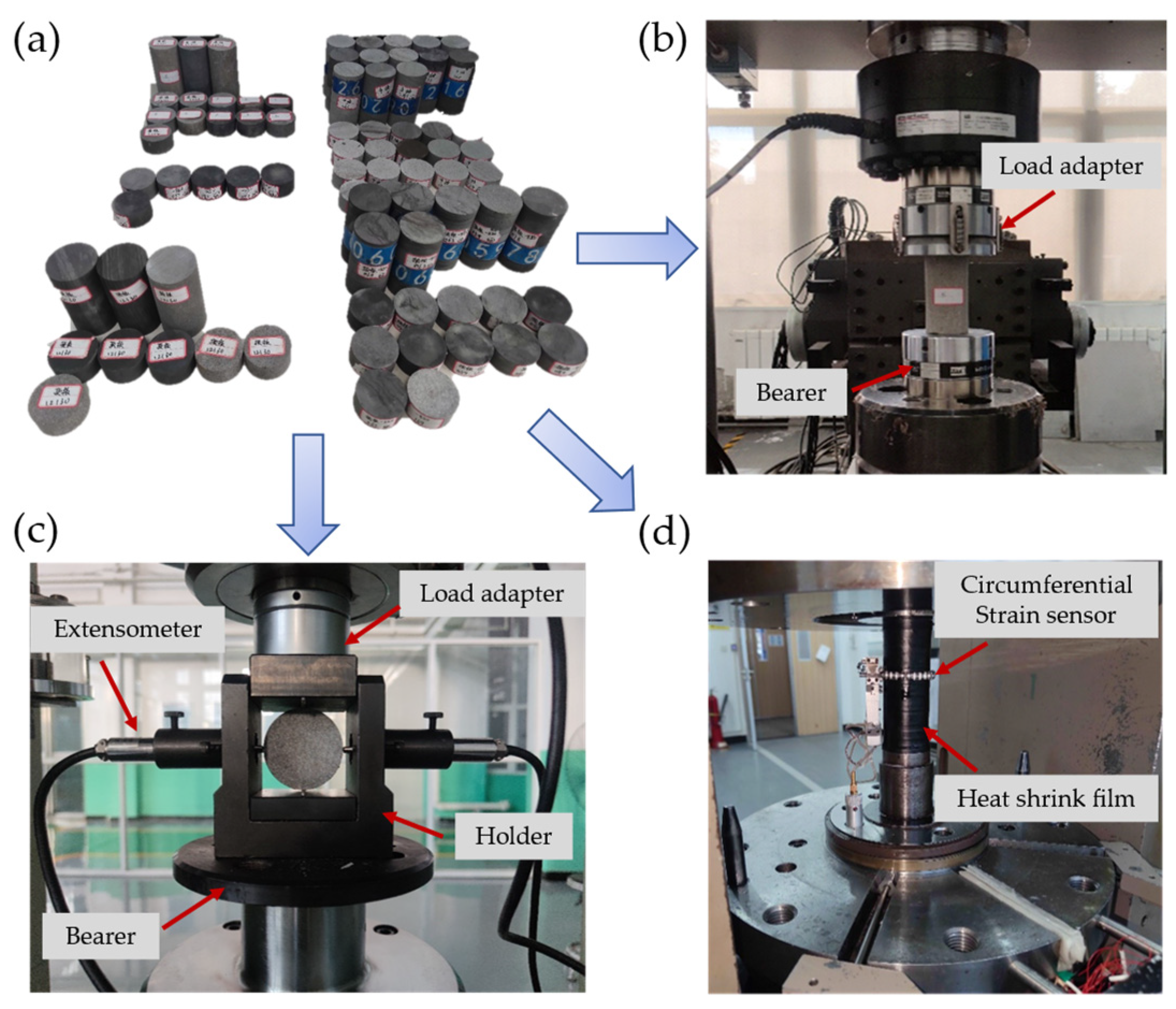
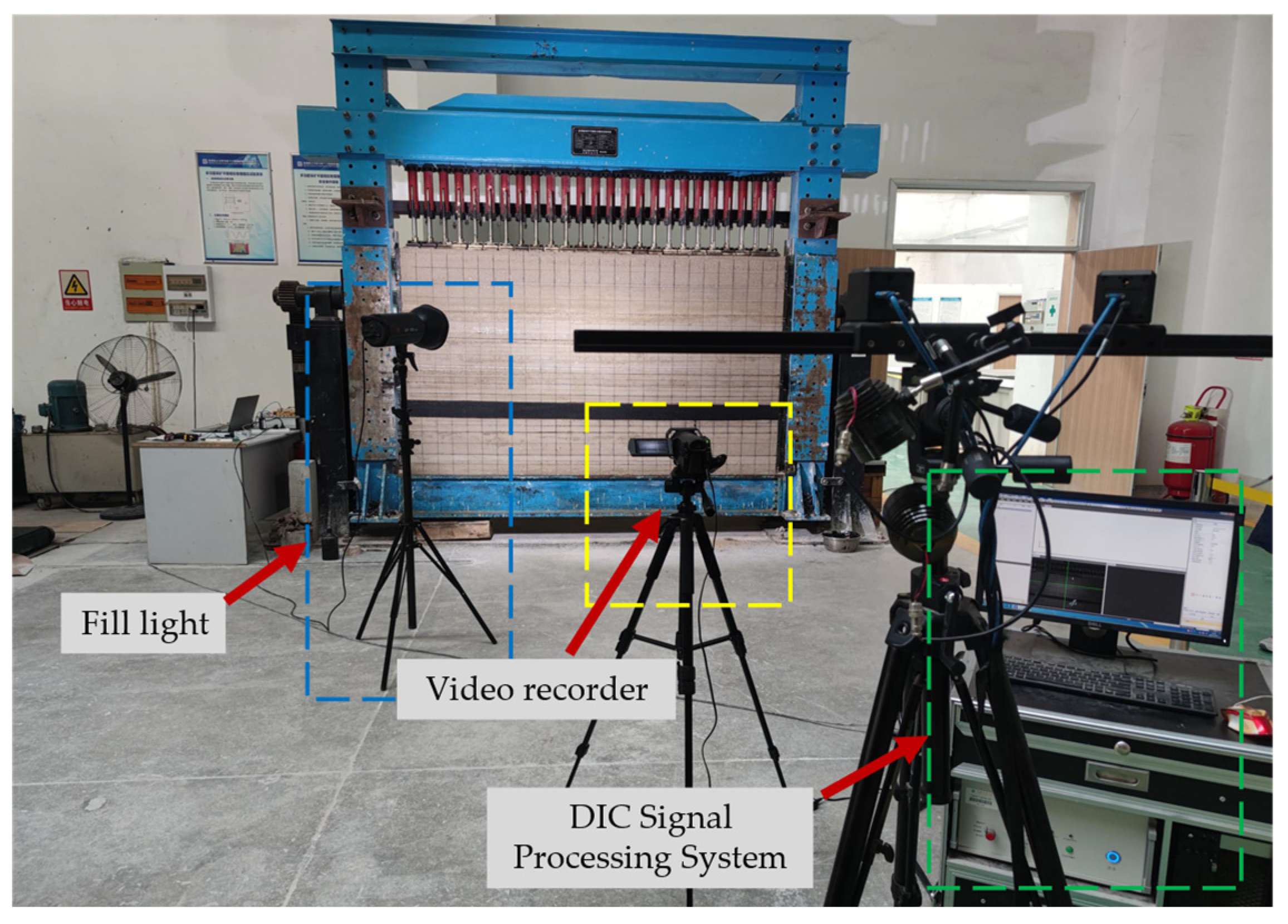
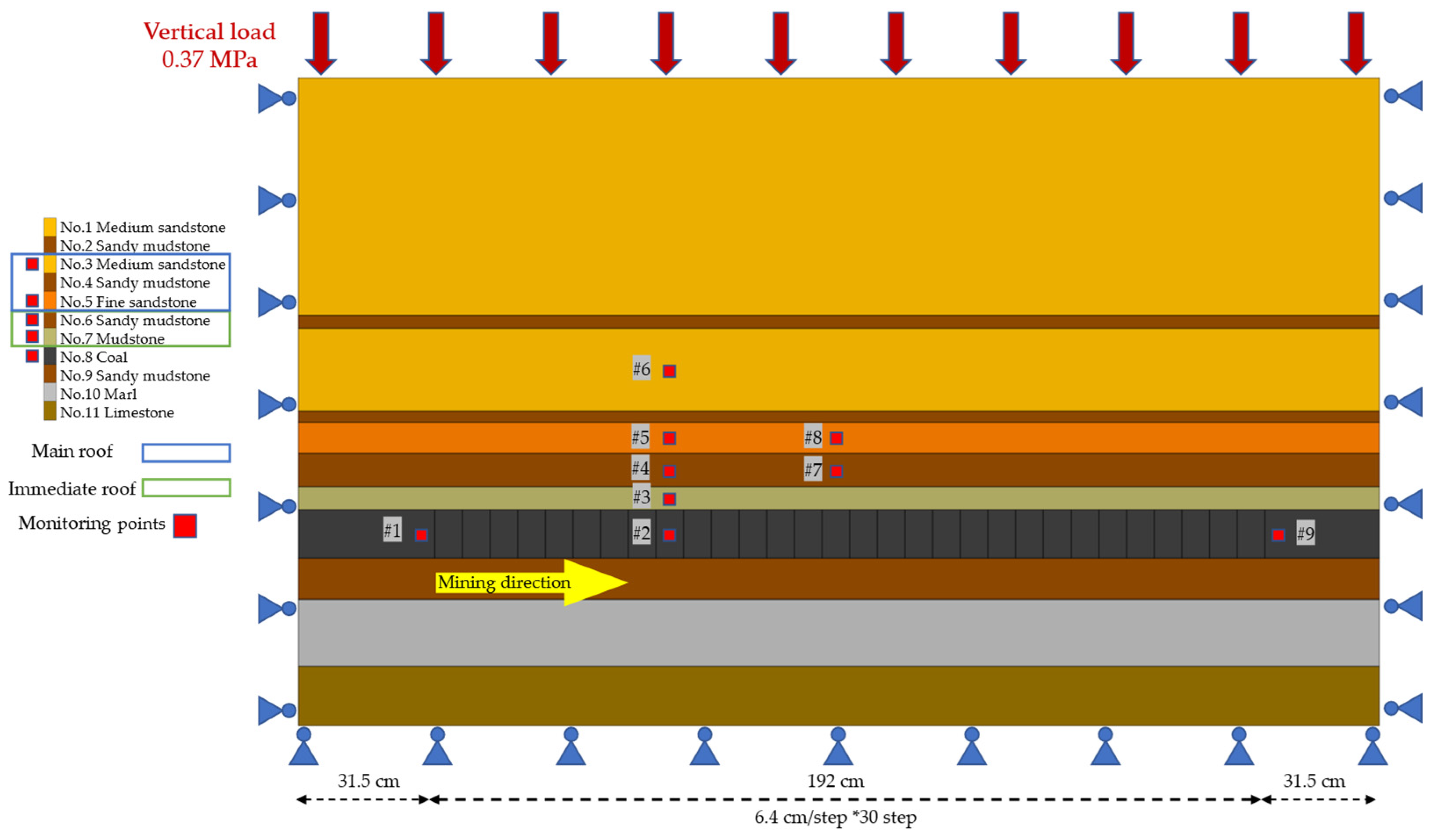
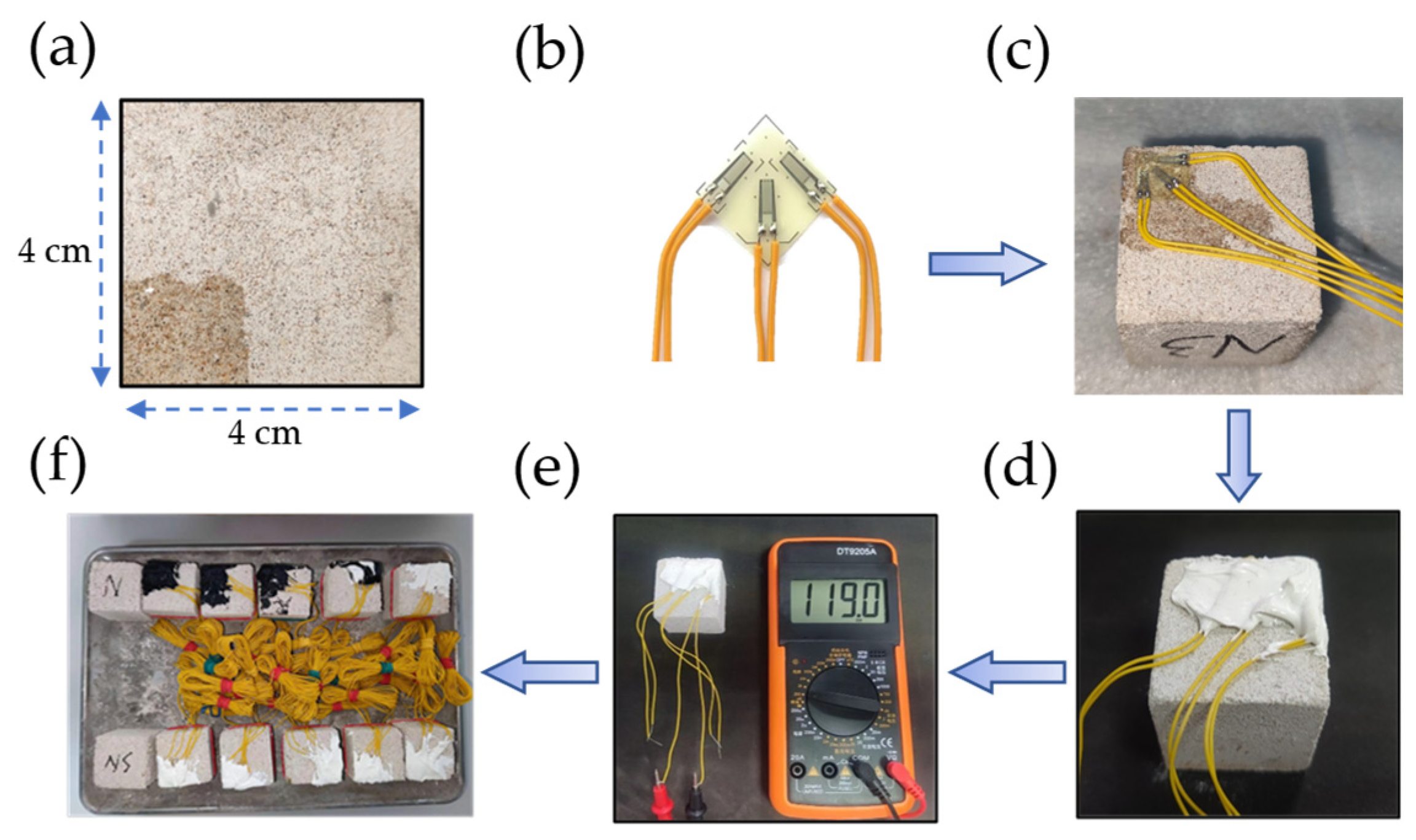
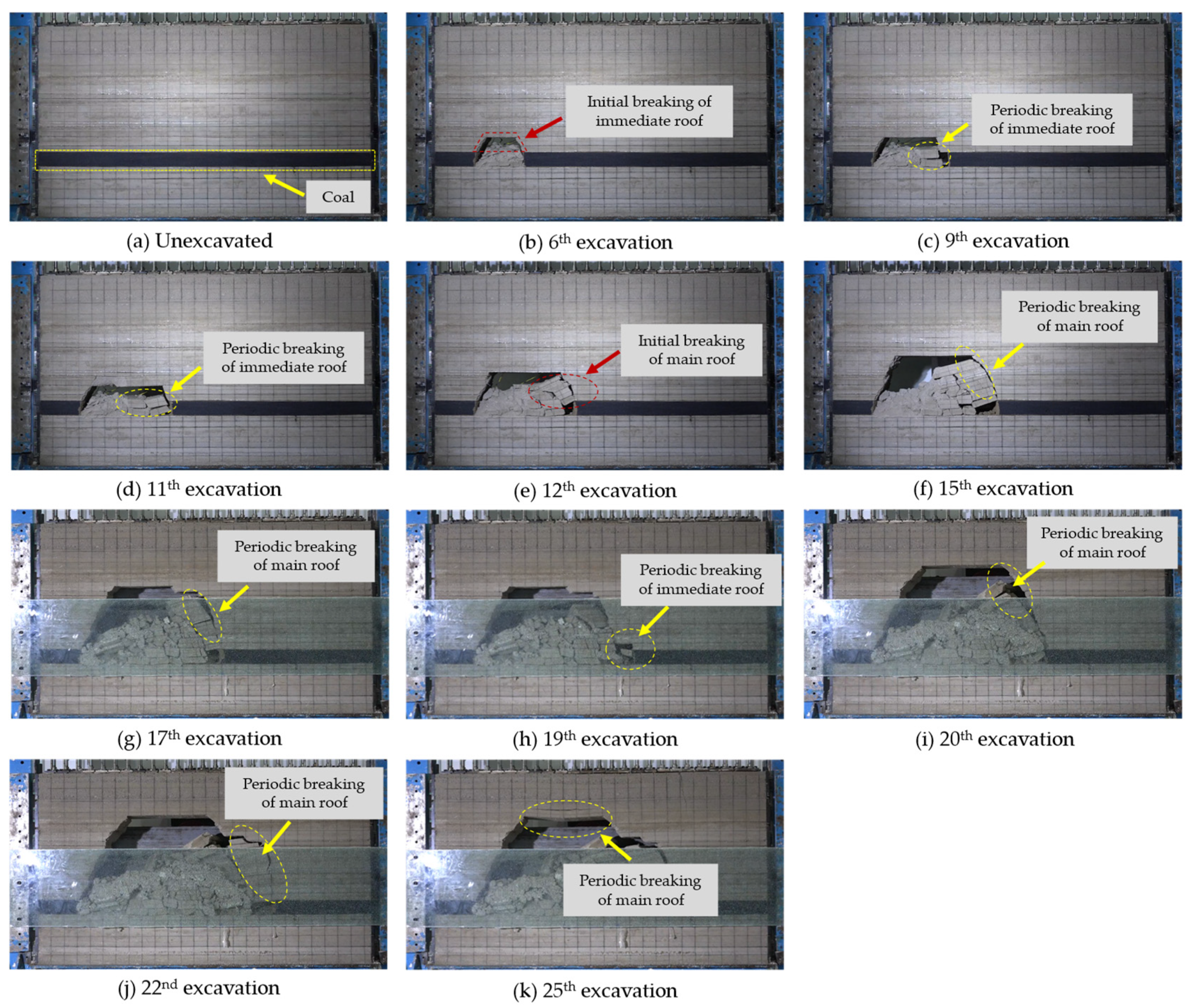
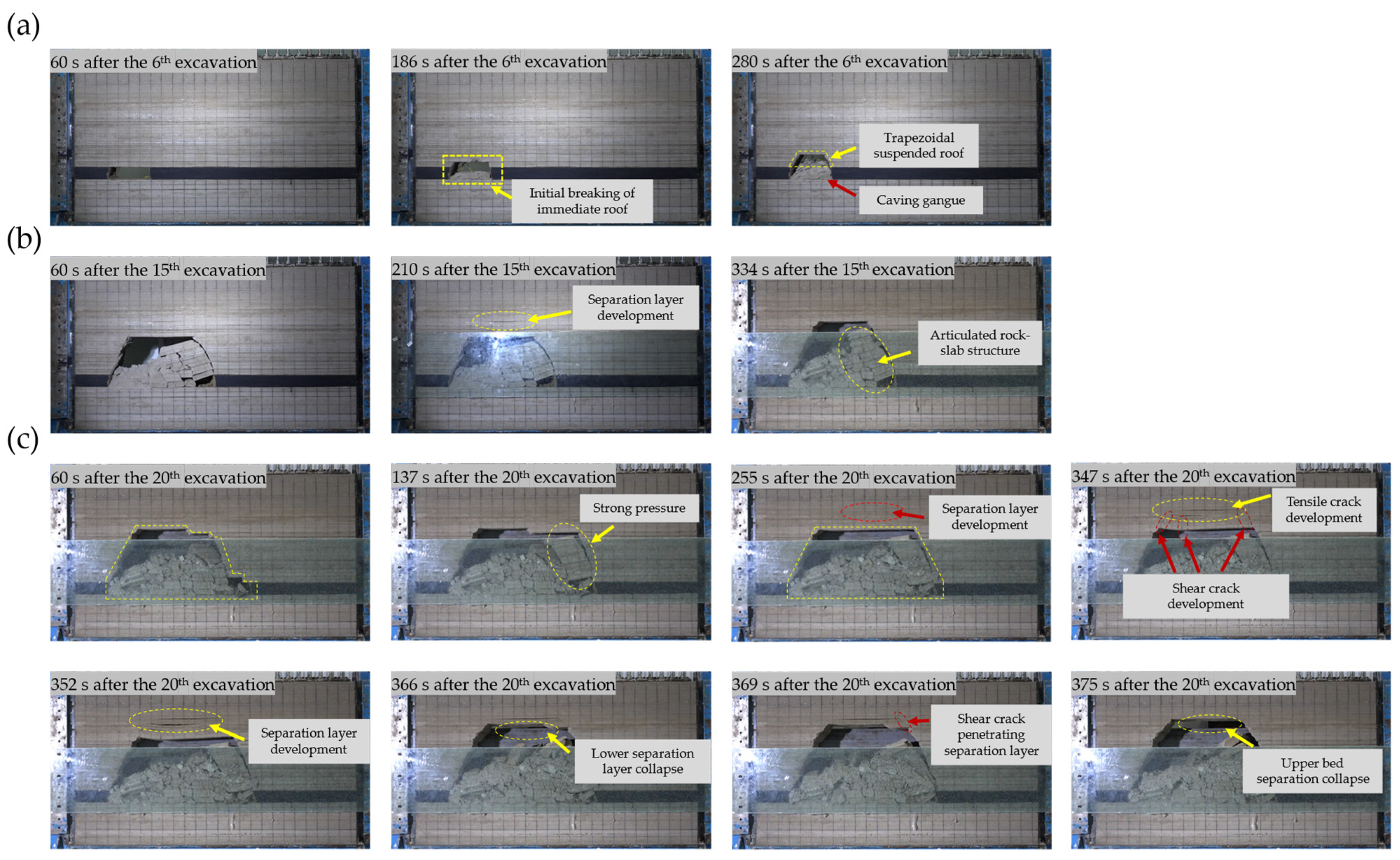

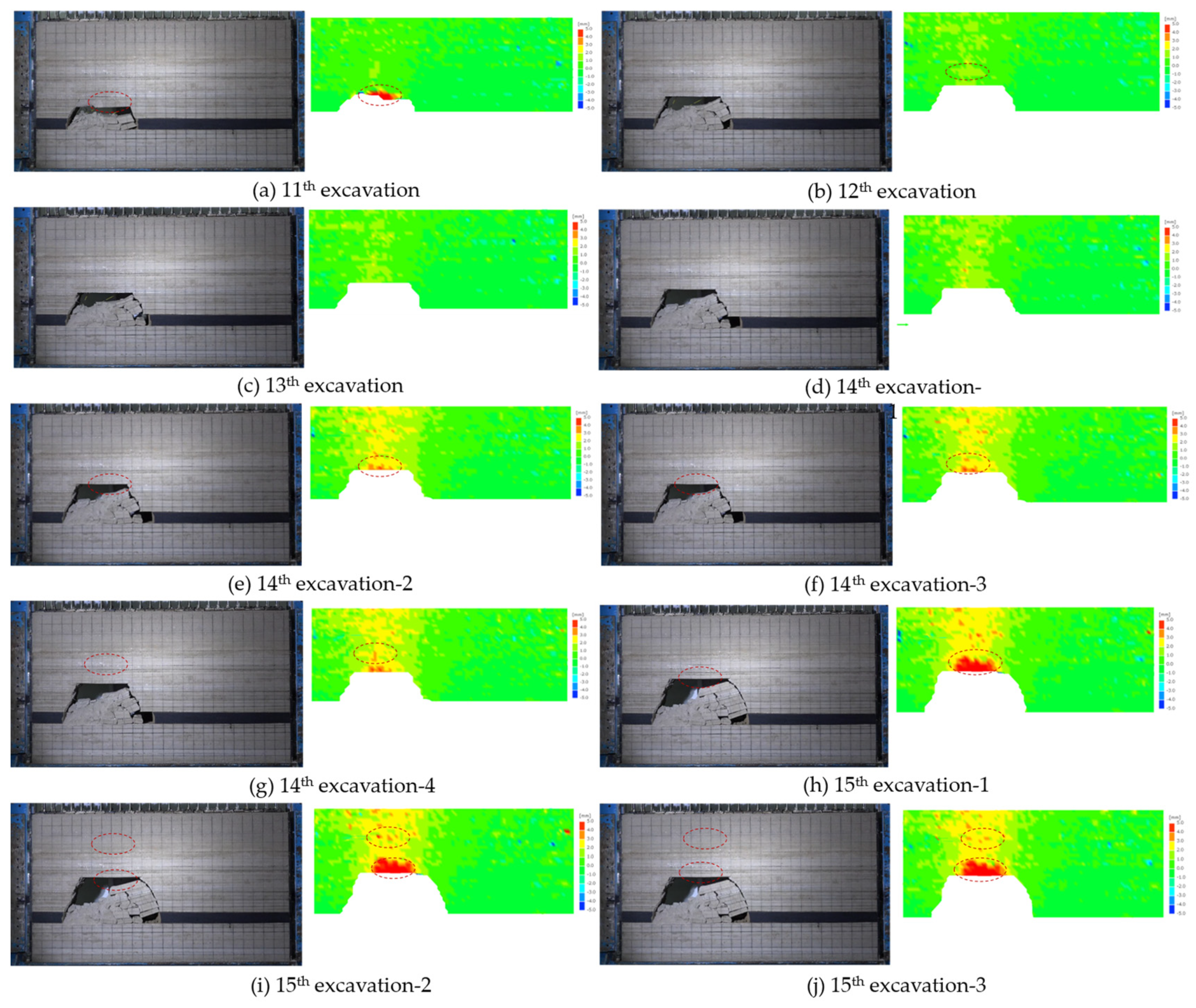
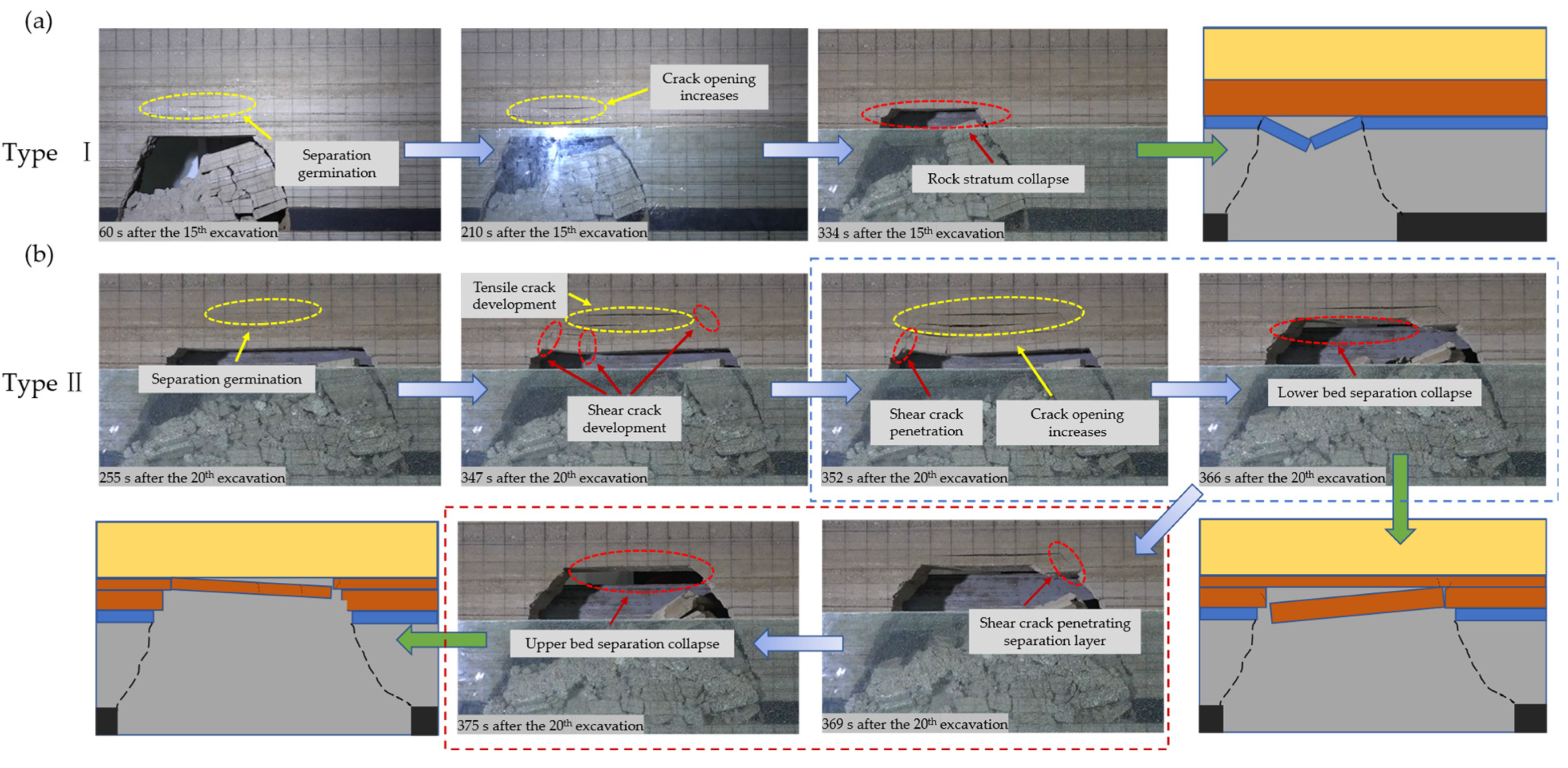
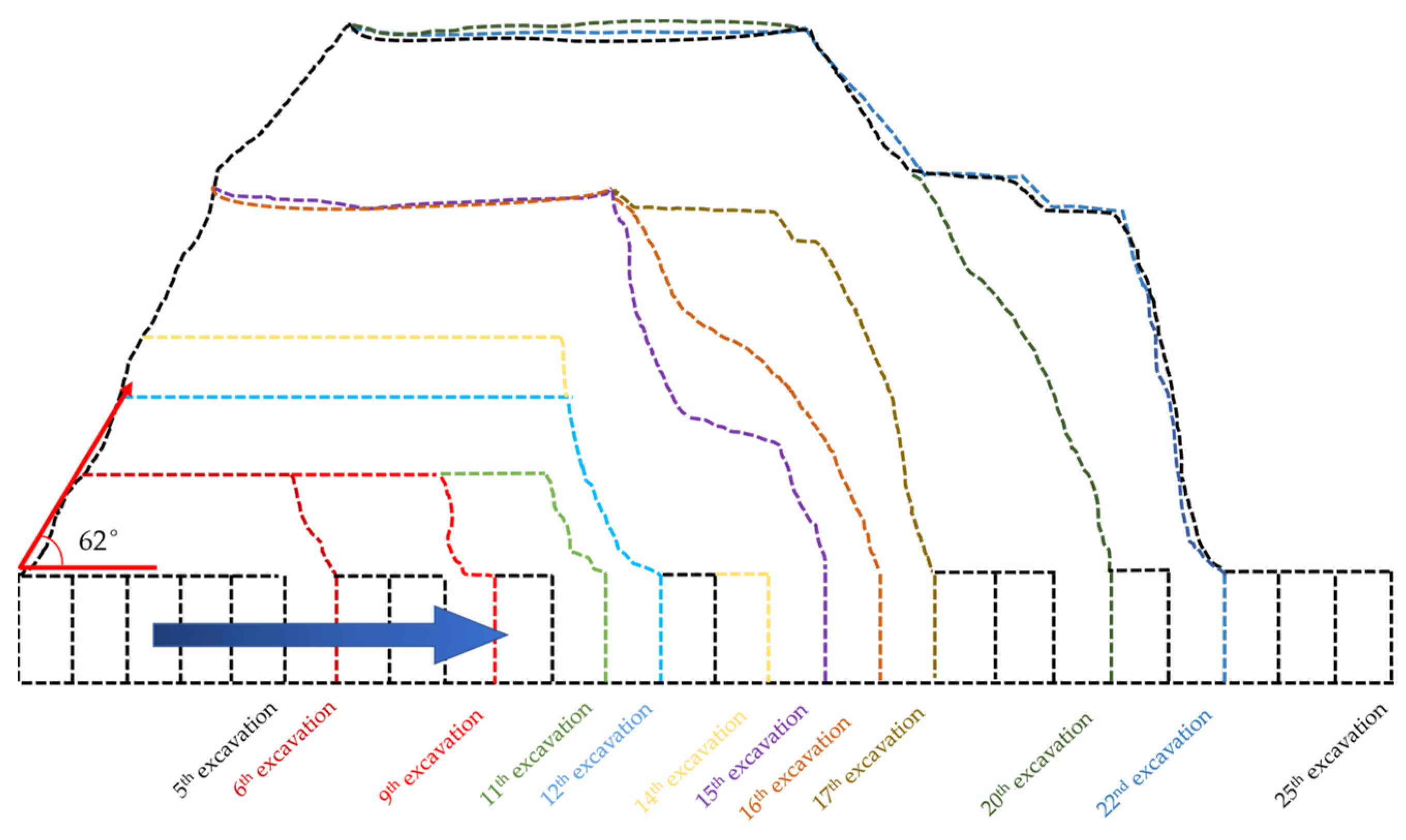

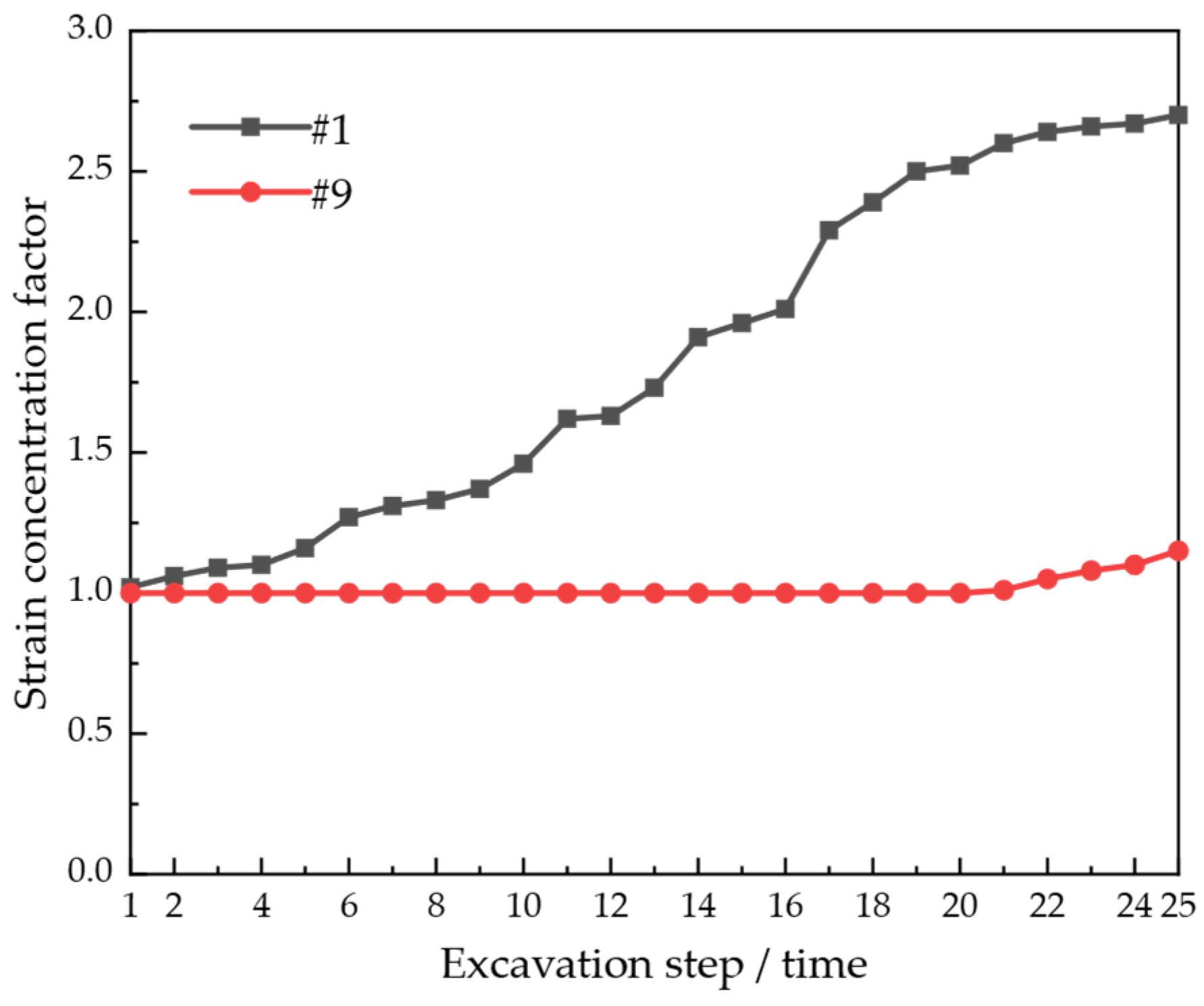
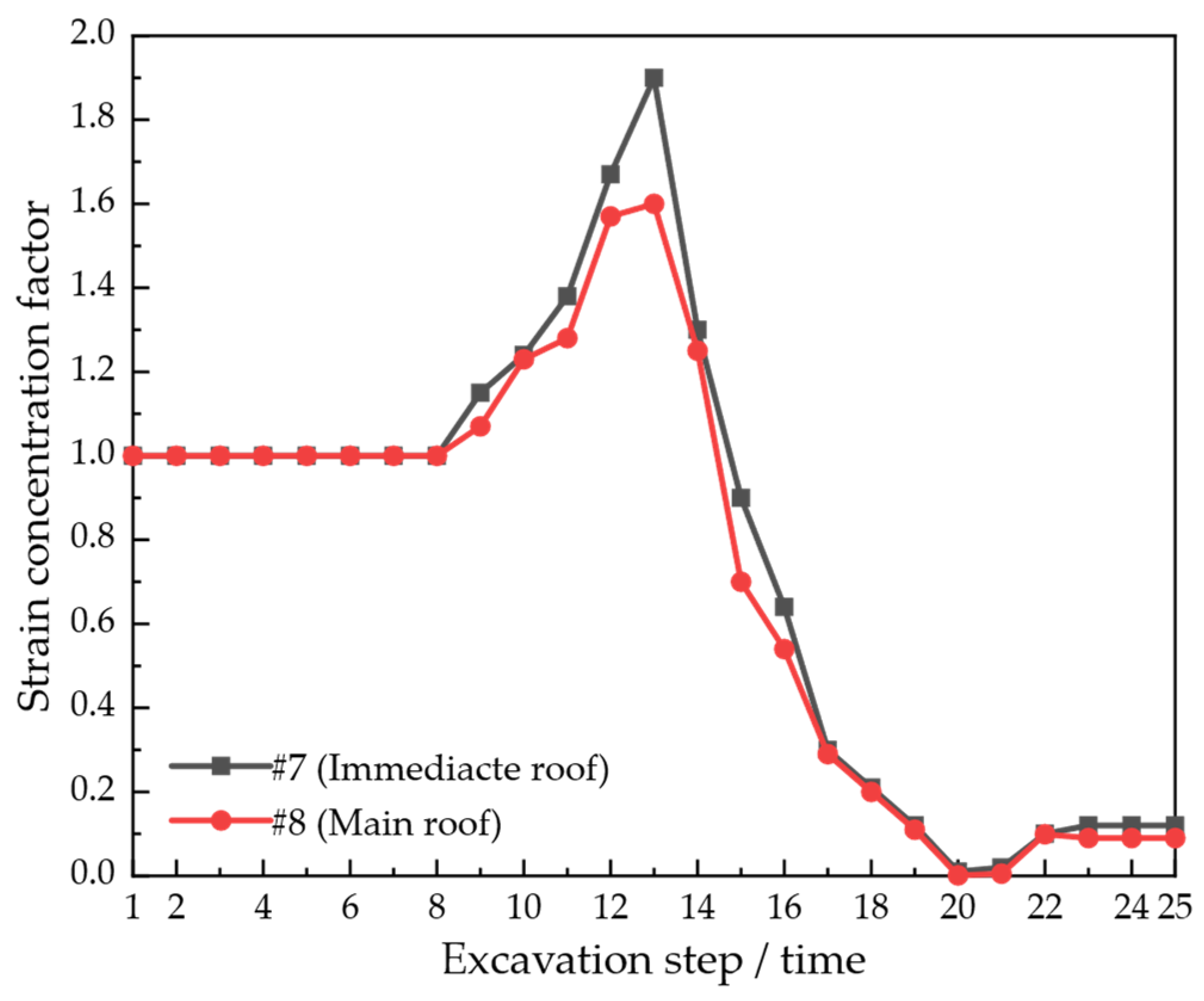
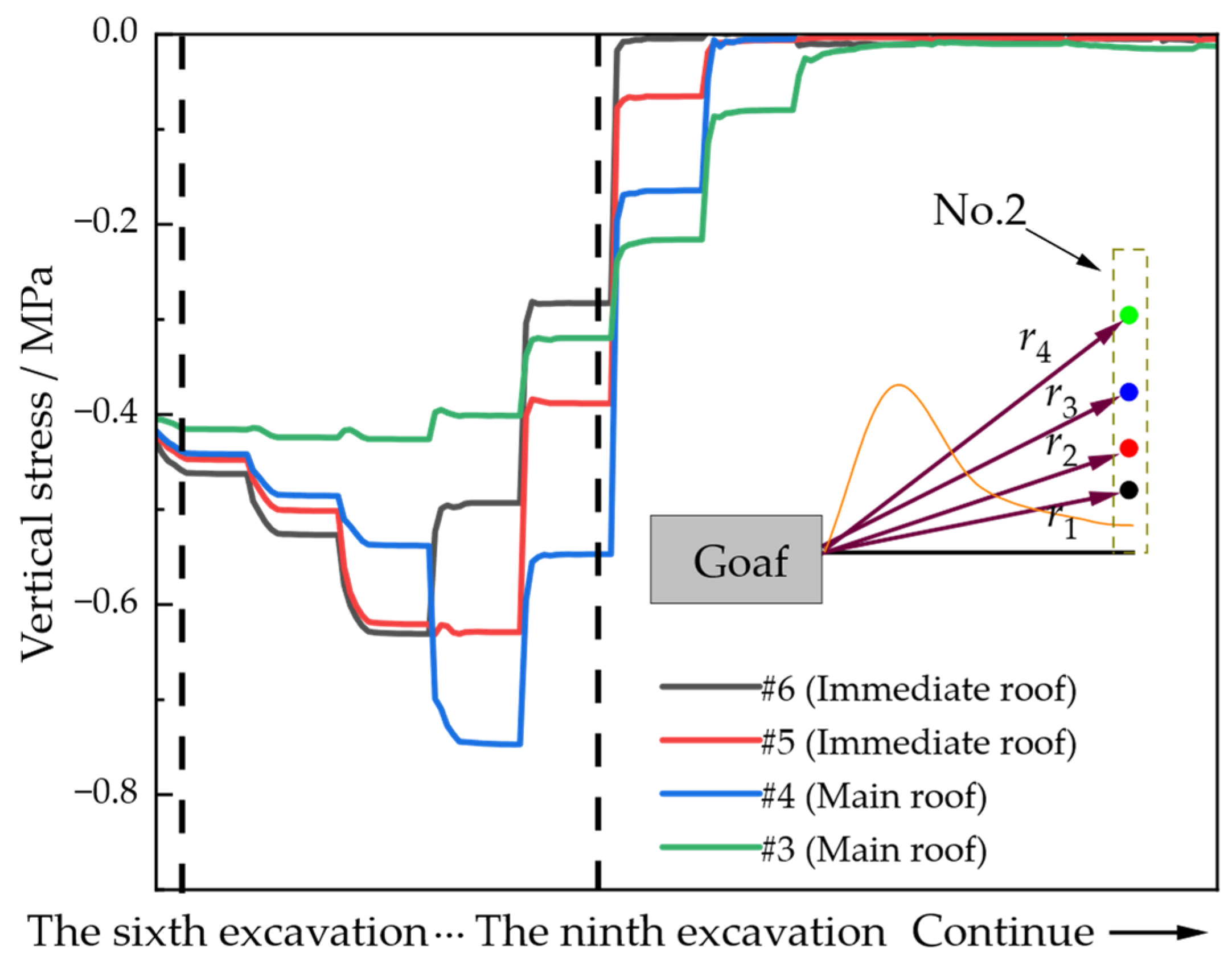
| Buried Depth/m | NO. | Lithology | Thickness/m | Lithological Description |
|---|---|---|---|---|
 | 1 | Medium sandstone | 27.5 | Medium thick layer, siliceous and calcareous cementation, with wavy bedding, and the layer contains a lot of muscovite flakes. |
| 2 | Sandy mudstone | 1.5 | Massive, dense, containing fossils of Koda plants. | |
| 3 | Medium sandstone | 9.6 | Medium thick layer, siliceous and calcareous cementation, with wavy bedding, and the layer contains a lot of muscovite flakes. | |
| 4 | Sandy mudstone | 1.3 | Massive, dense, containing fossils of Koda plants. | |
| 5 | Fine sandstone | 3.6 | Good sorting ability, medium thick layered, siliceous and calcareous cementation, with wavy bedding. | |
| 6 | Sandy mudstone | 3.8 | Medium thick layered, containing a small amount of plant fossil fragments. | |
| 7 | Mudstone | 2.7 | Dense, brittle, with slip surface, locally containing siderite nodules, easy to separate layer falling off, containing plant fossil fragments. | |
| 8 | Coal | 5.6 | Black, powdery, glassy, mainly bright coal, containing pyrite nodules. | |
| 9 | Sandy mudstone | 4.8 | Block shaped; mirror shaped. It is locally sandstone with discontinuous wavy bedding, and the bedding layer contains a lot of muscovite slices. | |
| 10 | Marl | 7.7 | Medium thick layer, cryptocrystalline structure, containing brachiopod fossils and animal debris. | |
| 11 | Limestone | 16.0 | Medium thick layer, containing biological fossils and more mud, calcite film on fracture surface. |
| No. | Lithology | Density/kg/m3 | Elastic Modulus/GPa | Tensile Strength/MPa | Compressive/MPa | Cohesion/MPa | Friction/° |
|---|---|---|---|---|---|---|---|
| 1 | Medium sandstone | 2700 | 28.5 | 3.60 | 36.00 | 2.06 | 40 |
| 2 | Sandy mudstone | 2510 | 5.4 | 0.75 | 22.80 | 2.16 | 36 |
| 3 | Medium sandstone | 2700 | 28.5 | 3.60 | 36.00 | 2.06 | 40 |
| 4 | Sandy mudstone | 2510 | 5.4 | 0.75 | 22.80 | 2.16 | 36 |
| 5 | Fine sandstone | 2730 | 33.4 | 6.44 | 42.20 | 3.20 | 41 |
| 6 | Sandy mudstone | 2510 | 5.4 | 0.75 | 22.80 | 2.16 | 36 |
| 7 | Mudstone | 2460 | 8.7 | 3.29 | 18.20 | 1.20 | 32 |
| 8 | Coal | 1400 | 5.3 | 0.50 | 11.50 | 1.25 | 27 |
| 9 | Sandy mudstone | 2510 | 5.4 | 0.75 | 22.80 | 2.16 | 36 |
| 10 | Marl | 2600 | 25.0 | 4.90 | 41.80 | 6.72 | 38 |
| 11 | Limestone | 2650 | 36.0 | 5.28 | 50.80 | 8.90 | 42 |
| No. | Lithology | Thickness/cm | Density/kg/m3 | Elastic Modulus/GPa | Tensile Strength/MPa | Compressive/MPa | Cohesion/MPa | Friction/° |
|---|---|---|---|---|---|---|---|---|
| 1 | Medium sandstone | 55.0 | 2700 | 28.5 | 3.60 | 36.00 | 2.06 | 40 |
| 2 | Sandy mudstone | 3.0 | 2510 | 5.4 | 0.75 | 22.80 | 2.16 | 36 |
| 3 | Medium sandstone | 19.2 | 2700 | 28.5 | 3.60 | 36.00 | 2.06 | 40 |
| 4 | Sandy mudstone | 2.6 | 2510 | 5.4 | 0.75 | 22.80 | 2.16 | 36 |
| 5 | Fine sandstone | 7.2 | 2730 | 33.4 | 6.44 | 42.20 | 3.20 | 41 |
| 6 | Sandy mudstone | 7.6 | 2510 | 5.4 | 0.75 | 22.80 | 2.16 | 36 |
| 7 | Mudstone | 5.4 | 2460 | 8.7 | 3.29 | 18.20 | 1.20 | 32 |
| 8 | Coal | 11.2 | 1400 | 5.3 | 0.50 | 11.50 | 1.25 | 27 |
| 9 | Sandy mudstone | 9.6 | 2510 | 5.4 | 0.75 | 22.80 | 2.16 | 36 |
| 10 | Marl | 15.4 | 2600 | 25.0 | 4.90 | 41.80 | 6.72 | 38 |
| 11 | Limestone | 13.8 | 2650 | 36.0 | 5.28 | 50.80 | 8.90 | 42 |
Disclaimer/Publisher’s Note: The statements, opinions and data contained in all publications are solely those of the individual author(s) and contributor(s) and not of MDPI and/or the editor(s). MDPI and/or the editor(s) disclaim responsibility for any injury to people or property resulting from any ideas, methods, instructions or products referred to in the content. |
© 2023 by the authors. Licensee MDPI, Basel, Switzerland. This article is an open access article distributed under the terms and conditions of the Creative Commons Attribution (CC BY) license (https://creativecommons.org/licenses/by/4.0/).
Share and Cite
Zhang, J.; Qin, X.; Liu, S.; Su, H.; Yang, Z.; Zhang, G. Study on Overburden Fracture and Structural Distribution Evolution Characteristics of Coal Seam Mining in Deep Large Mining Height Working Face. Sustainability 2023, 15, 13365. https://doi.org/10.3390/su151813365
Zhang J, Qin X, Liu S, Su H, Yang Z, Zhang G. Study on Overburden Fracture and Structural Distribution Evolution Characteristics of Coal Seam Mining in Deep Large Mining Height Working Face. Sustainability. 2023; 15(18):13365. https://doi.org/10.3390/su151813365
Chicago/Turabian StyleZhang, Jianguo, Xiaofeng Qin, Shuaitao Liu, Haijian Su, Zhanbiao Yang, and Guochuan Zhang. 2023. "Study on Overburden Fracture and Structural Distribution Evolution Characteristics of Coal Seam Mining in Deep Large Mining Height Working Face" Sustainability 15, no. 18: 13365. https://doi.org/10.3390/su151813365
APA StyleZhang, J., Qin, X., Liu, S., Su, H., Yang, Z., & Zhang, G. (2023). Study on Overburden Fracture and Structural Distribution Evolution Characteristics of Coal Seam Mining in Deep Large Mining Height Working Face. Sustainability, 15(18), 13365. https://doi.org/10.3390/su151813365





